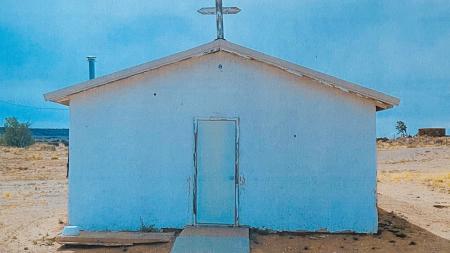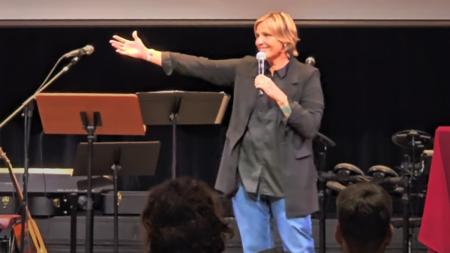Call Project Finds Joys, Challenges

Christian Reformed Church in North America personnel have been contacting CRCNA congregations over the past two months to see how they are responding to and coping with the COVID-19 pandemic.
More than 40 callers have found that churches are facing challenges but are doing fairly well — and many congregations are dealing with stay-at-home and social-distancing orders in creative ways.
Churches, like many other organizations across North America, have needed to shut their doors and, where possible, to seek other ways to do their work and connect with people.
In hopes of finding out how lockdowns have been affecting churches, the callers have so far contacted more than 620 churches and have had more than 1,000 interactions with people, said Scott DeVries, director of the CRCNA contact center advising the project.
“The motivation behind the calls had been a concern that churches might need some help, especially with things like technology for online worship and online finances,” said DeVries.
And callers have found that some congregations did need help, he said, “but we quickly began to discover that our pastors and councils are quite adaptive and creative, as a general rule.”
So, before long, the focus of the effort, he said, “became more about finding out how God was already working through churches and their leaders — and how we could join in and be there for emotional and spiritual support.”
Most of the callers are local mission leaders from Resonate Global Mission as well as Resonate advancement staff. In addition, the CRC customer support group has made many calls as well. A number of callers from the CRC’s Congregational Services ministries helped too.
At this point, “the formal initiative is done, but we're hoping that most of these aren't just one-time calls. . . . We're hoping this was just the start of something that continues,” said DeVries.
Among other things, said DeVries, he would like to see denominational staff, himself included, establish relationships that allow the CRCNA to offer ongoing prayer for the church.
“One of my dreams is that someday soon every CRC church will be paired with a CRC staff person whom they know is praying for them and is always available if they need something from the denominational offices. This project feels like a giant step forward toward realizing that dream,” he said.
Staff members who first thought up this project wanted to move from making educated guesses on how to serve churches during COVID-19 lockdowns to providing resources and services in direct response to what we were hearing from churches.
“What we've heard has also helped us to remove some of the resources that weren't as helpful so that the more fitting ones stand out better. I also think that as we have time to look closer at the information we’ve gathered, it will help us to reshape resources and services that may have been around a long time but need some tweaking to fit this unique situation,” said DeVries.
Here is a mixture of some of the reactions callers received to the questions they asked — in the words of either the caller or the people they spoke with.
Where do you see God at work?
- From a church that had international or exchange students: “This unique opportunity from meeting online has meant that the students who have returned to their home countries have been able to tune in and have shared worship with those at home (upwards of 30).”
- “Pre-existing relationships/groups are helping those wanting to connect with each other. Informal connections are really holding groups together.”
- “A pastor calls everyone in the church, most of whom don’t have computers or smartphones. The pastor also is sharing through TV and radio. People appreciate those checking in. Community within the church is strong. Preexisting networks of pastors and local services are critical for continuous engagement in those areas at this time. There is a different approach between church planters and pastors of established churches because church planters are engaged with the community already. One church is delivering a common meal to different people.”
- “I think the area of significant presence has been the breaking down of barriers/firming up relationships between other churches (though, sadly, a few built higher walls). As the source site for the [local area pantry], we have received phenomenal support in terms of funds and staffing and prayer support to cover the 600 percent increase in demand — also support from the community, including the township, school teachers from public schools, and others. The gifts and experience of retired medical professionals in the church has been very helpful. God is good!”
- “There has been great participation in the online prayer events and public reading of Scripture events!”
- “Churches that are more connected in their communities are able to provide social and emotional support and care during this time (which is more needed than physical things). . . . People and pastors are naming their neighborhood as a mission field, even if they aren't ready to live into that.”
- “Some churches are talking about meeting in small groups/houses and are looking to our missional-community church plants to learn more how to do that. The materials churches are putting online now are there for anyone who may be too intimidated to go to church. How do pastors consider the timelessness of their messages for people that may access them months or years from now?”
- “We’re encouraged by the number of people joining online; services are accessible to people who can't always go to church. Seeing an increase in opportunities for children and young people to lead in worship (like when a pastor's whole family is involved from their living room). Greater collaboration in classis — such as a classis prayer service — bringing a spirit of unity. Encouraging more personal discipleship practices and passing these on to the next generation.”
- Some information from a CRC congregation in Indianapolis: They are a unique congregation that consists of four groups — three in senior living centers and one in a YMCA. The pastor is doing sermons — one per week — and daily devotions, both online and in print for senior centers. They have seen an increase in people watching. The pastor is seeing many people asking for prayer that wouldn’t otherwise do so, and many people are coming to God. He said that God is doing “a marvelous work right now.” Using a “concierge approach” to ministry, they are “going to” the people.
- Multiple pastors have reported enjoying the rest and slower pace of this season. They're questioning the busyness of “ministry as usual.”
- “Not meeting together made us realize how important our fellowship really was. We started meeting again (recently in person). That Sunday was like a homecoming celebration. We had no coffee after church, but many of the congregation stayed anyway to talk for an hour after church. Was wonderful to see the joy of God's people. Also saw the congregation reaching out to elderly members and widows without being asked. Going through this also forced us to become more high-tech. We are going to continue livestreaming our service indefinitely.”
- Most congregations are optimistic that God is using this as an opportunity to reset and reconsider. Some reflected that God is specifically calling them to expand the value they are placing on rest and family right now.
What are some of your biggest challenges?
- Some congregations are not sure if they can continue online services. The technology necessary is an expense that some older members aren't sure is needed.
- “Summer ministry programs usually touch around 2,500 lives. Some of those programs — maybe all — will be dramatically affected. This affects the overall hospitality ministry of the church quite a bit.”
- One church said they are discouraged because they cannot do in-person outreach. Also, people in the church still prefer to give offerings in person instead of online and are wondering how to do so.
- Online giving can work pretty well, but a number of churches have expressed a decline in giving during this time; a few are seriously concerned about going forward after this time. Some churches have a lot of people in medical positions and have great concerns for them.
- People are in the midst of grief, including the deaths of family members. A lot of pastors have frustration with the need to reach out when it’s necessary for people to be isolated. How can you do this at this time? Feelings of being disconnected from the community abound. Some churches aren’t thinking about connecting with other pastors, or they don’t already have many connections.
- A church found that it could not hold a funeral for a church member. It was tough for the church and the family. The family did feel . . . unsupported.
- From the director for an area church group: “Right now we are going by observing the stay-at-home and gatherings rules for reopening. This stay-at-home crisis has made for a difficult nomination process for council members.”
- “We are thinking outside the box how to cover for this year, given we are a church that by age and health is at high risk.”
- “We are a church unified in Christ but politically split. This problem is decades old and was not nipped previously by a leadership that propelled it. More recently, a firmer leadership model to maintain unity has been exercised.”
- “Our church is made up of a lot of poor people. They can't very easily access things that depend on wifi. Plus, they're struggling on account of unemployment, reduced hours. It's a scary time, and it's hard for them to stay connected.”
- People in medical professions are extremely weary. Giving is down. There is uncertainty about what ministry will look like in the future and whether the church can afford to pay the pastor. Concern for people on the fringes is growing — how are they being reached and connected with?
- Rural church communities find that internet connectivity is a challenge, and so is keeping in touch with members (often seniors) who do not have internet at all. Churches are coming up with creative ways to meet this challenge, but it is not ideal.
- It would be good to have information on how to navigate streaming and copyrights for online use. — both for streaming music that is self-produced but copyrighted as well as linking to existing YouTube videos as part of the service. [Please note, from the CRCNA’s Permissions Dept.: CCLI provides low-cost licensing for livestreaming, and the use of YouTube videos is generally not allowed without direct permission from the songwriter or the producer (usually the record label).]
- Many churches do not really like doing worship services online, even though it is going okay and they will continue to use it.
- Churches that are in transition (such as one that recently became vacant) are struggling to know who is in charge. Depending on their source of information, members’ understanding of the situation can be different, and there can be a wide variety of opinions about next steps.
- “Pastors are in a pressure cooker. They are struggling, and we are concerned. They can't be with people; they feel out of touch; they are not feeling like they are ministering well; they have Zoom fatigue; they don't check in with other pastors because it feels awkward. They are aware that congregants are also watching other preachers’ sermons, and they feel threatened; they have to manage the political tensions and the health/well-being of the community; they are tired and exhausted and are often asked to do way more than they previously did (like edit all of their worship videos).”
What resources have been helpful for you?
- “CRC tech grants have been huge for church plants. I've also found that some church staff I talked to were really happy to just talk through stuff and see what other churches are doing (breakout rooms after Zoom; delivering flowers to parishioners;; one church rewrote their pastor's job description, etc.). Other churches simply needed someone to help them uncover government resources.”
- One pastor is training some people to be mentors for anyone who might be joining for worship — they will announce on their livestream that for anyone who's new, there is someone available to connect with online and help them understand/navigate a relationship with Jesus and the church.
- One church purchased 500 plants from a greenhouse and made them available to individuals (10 per household) to give to a neighbor, with a note to offer support.
- Zoom gatherings with GEMS and/or Cadets provided increased connections with families from the local community. Also, some of these families are now watching services but have never set foot in the church itself.
- “One of the themes in the calls I made this week is that ministry leaders feel like they are managing multiple traumas simultaneously and that the trauma isn't over yet. I talked to many folks who feel tired, overwhelmed, and pressured to make things happen without the authority to make significant changes to accommodate new realities. They miss the relational joys of their work.”
- “Churches without pastors right now are in a tough spot— How to make decisions? How to do a pastor search? The strongest personalities are driving the agenda, and maybe they aren't the best voices; there are new opportunities in this season, which takes imagination — and it can be hard to imagine when you're just keeping your head above water. There is a big gap between churches that are moving forward and being creative and churches that are struggling and stuck. There are a lot of people emotionally hurting right now in our communities, and we don't know how to minister to them. There is also anxiety about how the issue is being politicized. What’s more, the most vulnerable population is also the group that most wants to come back into church, so we have this dilemma — How do we help them not feel rejected if they aren't welcome?”
- “It was good to speak with the pastor from Truro, Nova Scotia. A number of people in his congregation knew people who were killed in a local shooting, and, in fact, their church was meeting together via Zoom on the Sunday morning during the event. This has been traumatic for them and for their whole community, so this will be a matter for ongoing prayer and support. They feel they are doing well now, but some of the processing/grieving is only delayed because of COVID-19.”
- “God story: A church was livestreaming and didn't realize that the entire service was being broadcast through a speaker on their roof to the community outside of their church. When they realized it, they stopped it. But then a neighbor called and said she had been planning to end her life, but then heard the worship and it blessed her. The pastor is following up with her.”
- “The pastors we've talked to have been overwhelmingly grateful for the conversations, and so have the leaders in churches that are vacant and needed someone to reach out to them and pray for them. Some pastors have so appreciated having prayer at the end of these conversations that they have half-jokingly asked if we can just call back every week to pray for them!”
DeVries noted that most Korean CRC congregations received a Korean-language survey instead of a call. Variations of the call project attempted to reach all 1,023 CRC churches in the denomination. If you're not sure whether your church was reached, feel free to call 1-800-272-5125.


